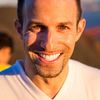Dina Litovsky is a very talented documentary photographer based in New York City. She recently covered various election events throughout 2016 for TIME, MSNBC, and Buzzfeed, as well as other news outlets. Her photographs often feature a distinctive visual style that frequently uses flash to emphasize a particular character or scene.
Dina’s work examines social performances and group interactions in both public and private spaces. This is evident in many of her personal projects as well as a good deal of her assignment work. Dina’s latest project, entitled Meatpacking, offers a fascinating glimpse into contemporary romance through its examination of the sexual politics on display in New York’s Meatpacking District.
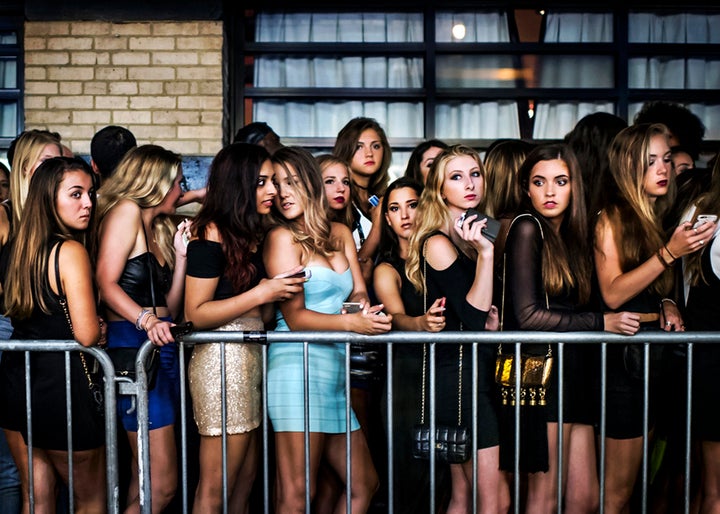
From the series Meatpacking
I recently sat down with Dina to learn more about the social psychology and the photographic techniques that make her work stand out. Here is my interview with Dina.
Ben Arnon: How do you think your Ukrainian background informs your approach to photography?
Dina Litovsky: The fact that it's Ukrainian doesn't really inform it. I don't remember Ukraine much, but I am still somewhat of foreigner so I look at things from an outsider's lens. I think there is a bit of a cultural barrier. I haven't internalized all the rituals, for example, that I'm photographing, like bachelorette parties.
You photographed a lot of this cycle’s election season. Did you feel any cultural barrier when photographing campaign events?
Initially I wasn't very interested in politics. I was not personally invested. Now, I think, it's because I didn't really understand it, how it really works. But when I saw the Nevada caucuses, to me I saw that [democracy] actually does work from some kind of [grassroots] level. There was one specific moment where there was a man who was undecided between Bernie and Clinton, and they spent 15 minutes convincing him to go to one side or another. To me that was such an interesting display that there is an actual democracy, and though you think your voice maybe doesn't matter, this guy's voice in some way actually did. I remember that moment and from then on I started paying more attention to politics and for the first time really getting the scoop on all the candidates and really following it. This is the only election that I followed very closely.
How old were you when you first knew that you wanted to be a professional photographer, that this was what you were passionate about and you wanted to do this?
I don't think I had a eureka moment. I got into it pretty much by accident. After I graduated from NYU, I was intending to go to med school, had a psychology degree, and then I changed my mind. I spent a couple of years just photographing my friends, and then I started doing weddings. It was essentially a hobby.
The first time I ever photographed I was maybe 23 or 24 years old. Around 23, with my first camera, I thought, “I'm going to do this until I find a real job, or a real profession.” I always kept looking for something. I wanted to be an art historian. After a few years I met Sasha, my husband, and he pretty much convinced me to go for a master's degree in photography.
How would you describe your photography? Are you a documentary photographer, a photojournalist, something else?
Not a photojournalist, I'm a documentary photographer. I don't know, labels are tricky. I think I'm not objective enough to be a photojournalist. I don't even try to be objective. I studied social psychology and that's exactly what I like photographing. The social situations, rituals, culture.
Do you think your psychology background has been helpful in terms of informing how you work with people, approach people, and approach situations?
Yes, helpful, but also I think it's kind of the foundation of what I'm looking for to photograph. I have a fascination with studying groups of people and public behaviors, so it drives my work. It’s a curiosity to explore the world through the camera. I do a lot of research for my projects, for example. Any time I start a project, halfway through, I read up a lot of relevant sociology/psychology material that relates to the specific subject. For instance, I read a book about the sociology of bachelorette parties when shooting the series. So I have this foundation of research which helps to inform my work.
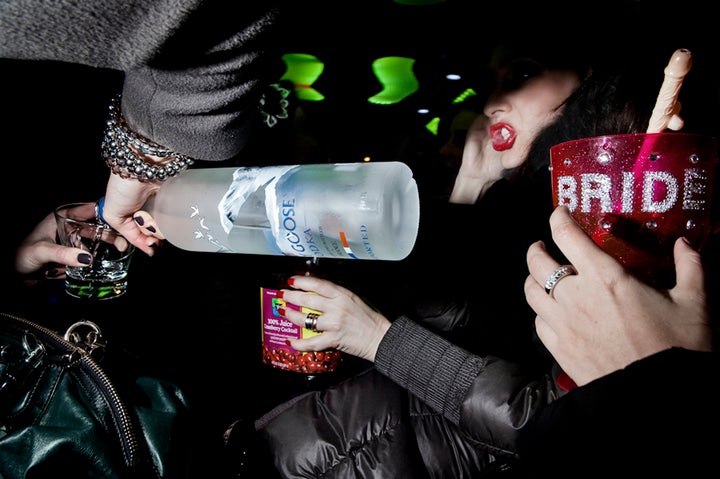
From the series Bachelorette
How do you decide which personal projects you work on? Describe the process. Additionally, how long do you work on these projects?
Bachelorette was about three years on and off. It's not a continuous project. On weekend nights I would go to bachelorette parties. I think from the first to the last party, it was about three years, and Meatpacking same.
In terms of how I get into it, I usually happen upon it. I went to my first bachelorette party of a friend and photographed just for fun, but then became interested in what came out of that. I started reading about bachelorette parties, and continued photographing them. Only after the first few, I thought this is turning in to a real project.
How did you convince people at the bachelorette parties to let their guard down and allow you to take all of these photographs?
There's definitely a lot of people who said no, but a lot of people said yes. I would offer a free photo shoot for the access. I said that I will only use one to two images from each event. Also, if there was real objection to using an image, I would not include it, though I don’t remember anyone asking me for that in the end. If the bachelorette didn't want me to shoot at a specific moment, I always put the camera down.
Many of your photographs, especially the political ones, use a strong flash which creates a very distinctive style. You obviously get really close to your subjects as well. How would you describe your process and your approach when photographing, say the RNC Convention, or any of these events where you're right up in people's faces with the flash? From both a psychological perspective and a technical perspective, what's going through your mind?
It's a handheld flash that’s on a wireless transmitter. I often photograph in very chaotic scenes and I like how it can isolate the subject. With this flash I can really decide on my focus, and not have to depend on ambient light. This is what separates, I guess in my mind, photojournalism from documentary. I kind of influence the picture with the light. I can isolate a subject in a crowded room and make it seem like he/she is the only person in the space. I can emphasize something which wouldn't be emphasized otherwise. I use flash almost like a theatre light shining on a specific part that I want the viewer to pay attention to. And it can also distort. Again, I don’t really try to be very objective in my images. I can either use it to just emphasize something visually or as an opinion on the situation.
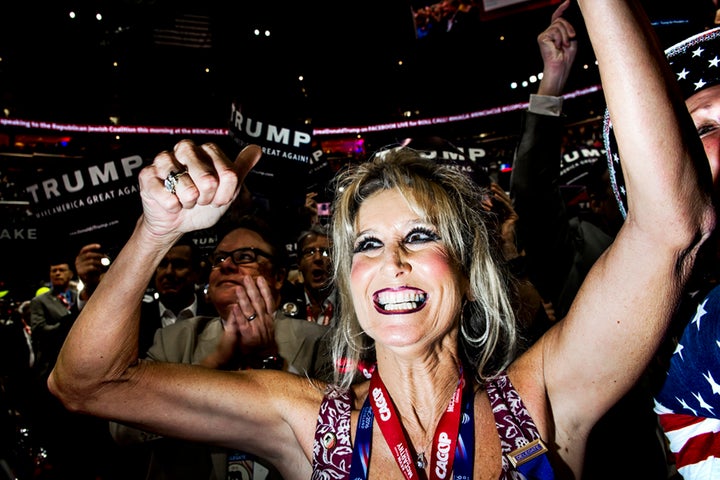
From the series RNC 2016
Can you elaborate on that? At the Trump election party, or at the RNC Convention, is there an image that you can highlight for us in which you wanted to create a certain type of reality, so you used light in a certain way?
For example, the closeup of the Trump supporters screaming at the Republican Convention is pretty harsh. The light is coming from down under. If I had a soft light, or the natural light, that woman would just be a woman screaming. I think with this light, it introduces a bit of the grotesque. Just a bit. I don't want to overdo it and make it Halloween style, but I definitely used that to emphasize whatever reality I saw in it.
I suppose a lot of these scenes are chaotic and frantic like you said, so people are sort of oblivious to their surroundings. But obviously if you're there photographing without a flash, it's very easy for them not to notice. With a big flash, do you ever have any situations where it throws people a little bit?
Of course, often. I have some tricks for them not to notice me. I never look in the person's eyes, so they don't know that I'm photographing them. Sometimes I photograph a few times and they get used to me and then they look away for a second. Sometimes they first pose, and then I say, 'Okay, now go on, whatever you were doing.' Sometimes it just doesn't work. Often people don’t expect the flash on the side and look at it instead of my camera, which can also sort of work. I have just one shot before they realize.
Tell me about the Meatpacking project. What was the genesis of that idea?
I found myself in the [New York City] Meatpacking district in 2012, and I was amazed. Again it's all the themes that I enjoy, like sexual politics, a lot of performance play, careful self- presentation and interesting interactions. The women are out on the town in a full armor of short dresses and high heels. These are the themes that I've been looking for in my work before, so it was mostly a curiosity to explore this further.
Only after a couple of summers it started crystallizing into a more coherent idea. I was really interested in the interplay between the sexes that happened outside. I've seen it before in clubs, but I've never really seen it in the streets, so open and blatant. In America especially, you don't look at people on the street. I tried street photography before, but it was too quiet for me. There weren't a lot of emotions and interactions. I like really expressive, theatrical scenes. Nobody looks at each other on the street. There's no connection.
In a weird way, this was the place that I've seen the most human connection in all of New York. People seem to totally lose a sense of decorum. The men would be gawking and whistling and looking. There were a lot of exchanges of glances and comments. It was like a theatre play being put on throughout the streets of the Meatpacking district.
When you were photographing Meatpacking, what was your process? Would you go out on, say, a Saturday night, and spend countless hours on the streets observing and photographing? Would you be out there all night?
I would have about three hours each night before it would start getting overwhelming. So usually it would be a three-hour night. I would either come earlier or come later, depending what I wanted to get. It was different pictures. Early it was much more about presentation, very careful self-assembly. Later at night it became a little more alcohol-fueled, looser, more chaotic.
Are there one or two photographs you've made during your career that really stand out to you as either your favorite, most memorable, or most meaningful for your career?
There's a picture of an audience from fashion week, I got lucky with that one. I wanted to photograph the audience, and I was trying at many shows, but it just didn't look how I imagined it could. Then I got this image from Paris when it was just rows of audience. Everybody's on their cellphones, and they’re all watching the show through their devices.
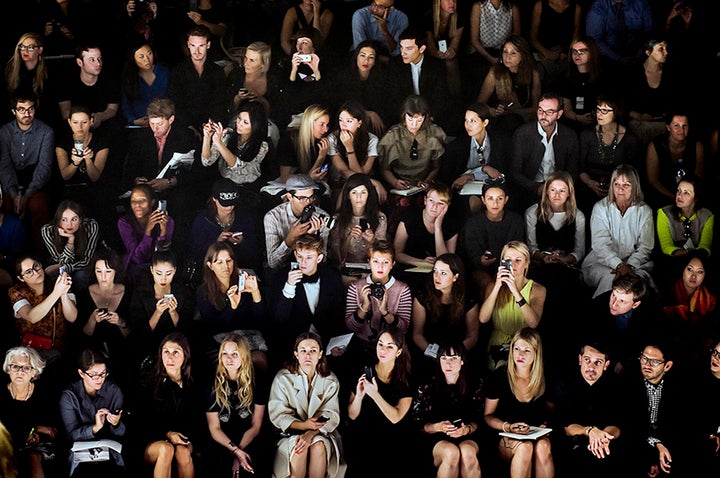
From the series Fashion Lust
What advice do you have for emerging or up-and-coming photographers?
Find what you are really interested in, and follow that, rather than trying to follow trends. Everybody has something they're passionate about, or have some kind of expertise in, and I feel like it's important to stay true to that.
In terms of assignment work, my lesson was that there are no small assignments. You can turn any assignment into something interesting if you just treat it as something that’s fun and relevant to you. I try to find something that catches me with every assignment. I think it's really important to treat every single job as maybe your best photo shoot ever.
